2-Stroke Squish & Compression Testing
Since many vintage engines have been “in the hands” of numerous mechanics in the past, there is no assurance that cases, cylinder decks, and heads have not been machined in the past. For this reason, we ask customers to send us a squish test (solder) and a current compression reading to help us get their top ends properly setup …. Here are the best procedures to get squish and compression readings.
Squish Testing - Squish is the thickness of the air gap between the piston crown and cylinder head when the piston is at top dead center.
The best way to find the thickness is to turn the engine over With the starter) while holding a piece of solder (inserted through the spark plug hole) to the edge of the bore. With several “strikes” at the soft solder, the piston will easily crush the solder to the exact squish clearance thickness. It’s important to place the solder to the left or right side of the bore (over the ends of the wrist pin). This helps to minimize amount of piston rocking that may affect the reading.
It sometimes happens that an engine has squish clearance that is much thicker than the solder you have in your garage. When this happens, the best solution is to twist together 2 or more pieces of solder until you get a visible strike surface on both sides of the solder.
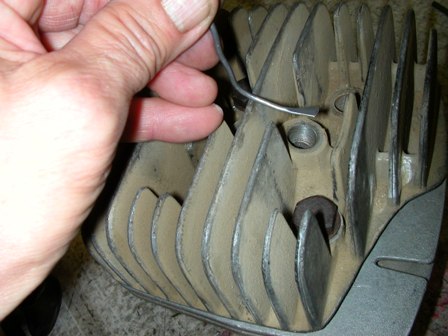 |
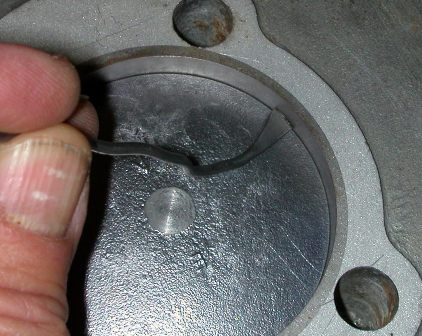 |
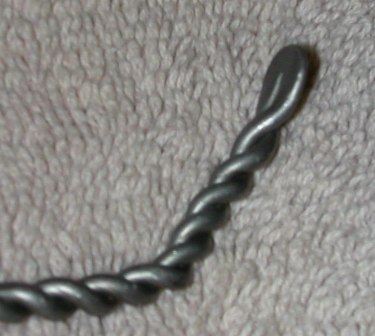 |
| The angled piece of solder is put in through the spark plug hole to the edge of the bore diameter. | To get the most useful test, the squish solder must be at the very outer edge of the piston. | This shows a solder twisted to offer greater thickness for thicker squishes. |
Compression Testing - Because of the broad variation in compression gauges, we generally don’t use compression readings for any sort of fine tuning. That said, a properly done compression test (with a good gauge) can help to see if something is “not quite right”.
A Brief Note About Compression Gauges - It bears noting that most compression gauges are made for automotive applications where V8 engines often have a swept compression volume of 700+ccs. Unfortunately, the average 125cc 2-stroke has a swept volume of about 70cc. This big difference in swept volume means that a valid compression test has to be done in a certain way with a particular type of gauge.
To get a meaningful reading, your gauge “must” be the type that screws into the spark plug hole (with a sealing “O” ring), and it “must” have a sealing air fitting at the tip of the threaded fitting. Without these features, the readings it yields are close to useless.
In addition, it’s helpful if your screw-in type gauge has a hose-volume that is as small as possible. If your compression gauge has an unusually large hose volume, you’ll need to spin the engine through a bit faster and longer to get a valid and repeatable reading.
The most popular compression gauge among mechanics is the very nicely made Snap-On gauge that comes with short-reach and long-leach spark plug thread adaptors. The Snap-on gauge is a perfect example of a gauge built for large-displacement cylinder automotive use, instead of small displacement 2stroke motorcycle use. The internal hose volume of the Snap-on gauge is over 10cc (Keep in mind that the entire combustion chamber volume of most 2-strokes under 125cc is 10cc or less). By contrast, the compression gauge sold by Kawasaki (to their dealers) has a hose with a 3cc inner volume. The much smaller hose volume of this Kawasaki gauge means that the engine will need to be spun through a lot fewer times to net a valid and repeatable reading. We consider this Kawasaki gauge to be head and shoulders the very best compression gauge for use on two-stroke....especially small-bore two-strokes. This gauge is sold in two parts, The gauge head and the hose adaptor. The Kawasaki part numbers for these are: 57001-221 -Gauge-Head 57001-1159 - Hose adaptor
It bears noting that the Kawasaki gauge consistently yields compression numbers about 10-15 psi higher than the Snap-On gauge on virtually any 2-stroke ..... Why?? We built a fixture so we could pressure test the gauges themselves (for leaks) as well as compare actual gauge readings. Every Snap-On gauge we have pressure tested (to date) up to 60psi, has a small leak at the pressure release button on the gauge base .... and many also have a small leak at the quick release coupler. Under the same test, the Kawasaki gauge & hose are 100% leak free. While the leaks we find in the Snap-On gauges are not big, they are big enough to leak off meaningful pressure during the momentary "spike" pressurizations of a normal 2-stroke compression test. These leaks do not have a very big effect on the readings when testing the 700cc swept volume of an automotive V8 engine. However when testing the 70cc swept volume of a 125 2-stroke, these leaks "are" meaningful. All these variables contribute to why we don't take compression reading too seriously.
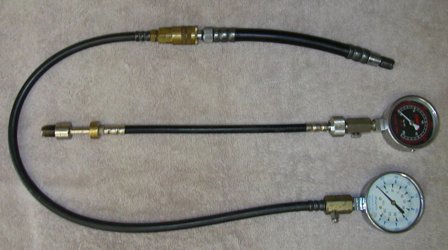 |
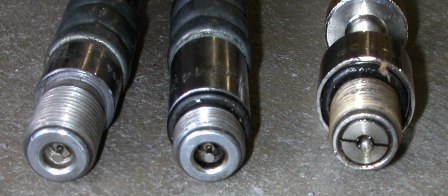 |
| The automotive Snap-On gauge with it's 10cc+ hose, and the Kawasaki gauge with it's 3cc hose. | The Snap-on adaptors (left) have an air valve that should be cleaned occasionally to avoid leakage. Do not use an adaptor with no "O" ring (as left) |
The Best Way to get a Valid Compression Reading
A) Within 5 days of a normal “operating cycle - Engines that have sat for a long time may have excess oil that has leaked in from somewhere. The added ring sealing offered by this excessive oil presence can greatly increase the normal valid reading.
B) Cold Engine only - Hot engines will yield lower numbers, and varying levels of temperature will yield varying levels of lowered readings.
C) Fuel Petcock “off” - To avert fire risks.
D) Throttle “must” be full open - To consistently allow the same air access to the lower end.
E) Spark plug mounted in cap and grounded to motor (to avoid harming ignition)
F) Put your machine in 1st or 2nd gear (use the same gear each time), and push the bike at a walking speed for about 10 feet (road-racers with very tall gearing should go 20ft). Doing the test in this way assures that the engine will always spin at the same speed, and that gauge gets enough "pressure hits" from the cylinder to correct for a gauge that may have an unusually large volume hose.
G) Repeat - It’s not a bad idea to do two or three tests (back to back) to assure consistency
Why not just use the kick starter ? - Because engine rotation speed, and the number of pressure "hits" will vary alot during "kick tests".... and so cause variations in the reading. Sadly, these variations are greatest on large displacement singles .... and large displacement singles are the hardest to push-test. Despite that, the effort is worth the accuracy. If you have doubts, do both a push-test and a kick-test on your machine is see what difference you get.... you'll be surprised.